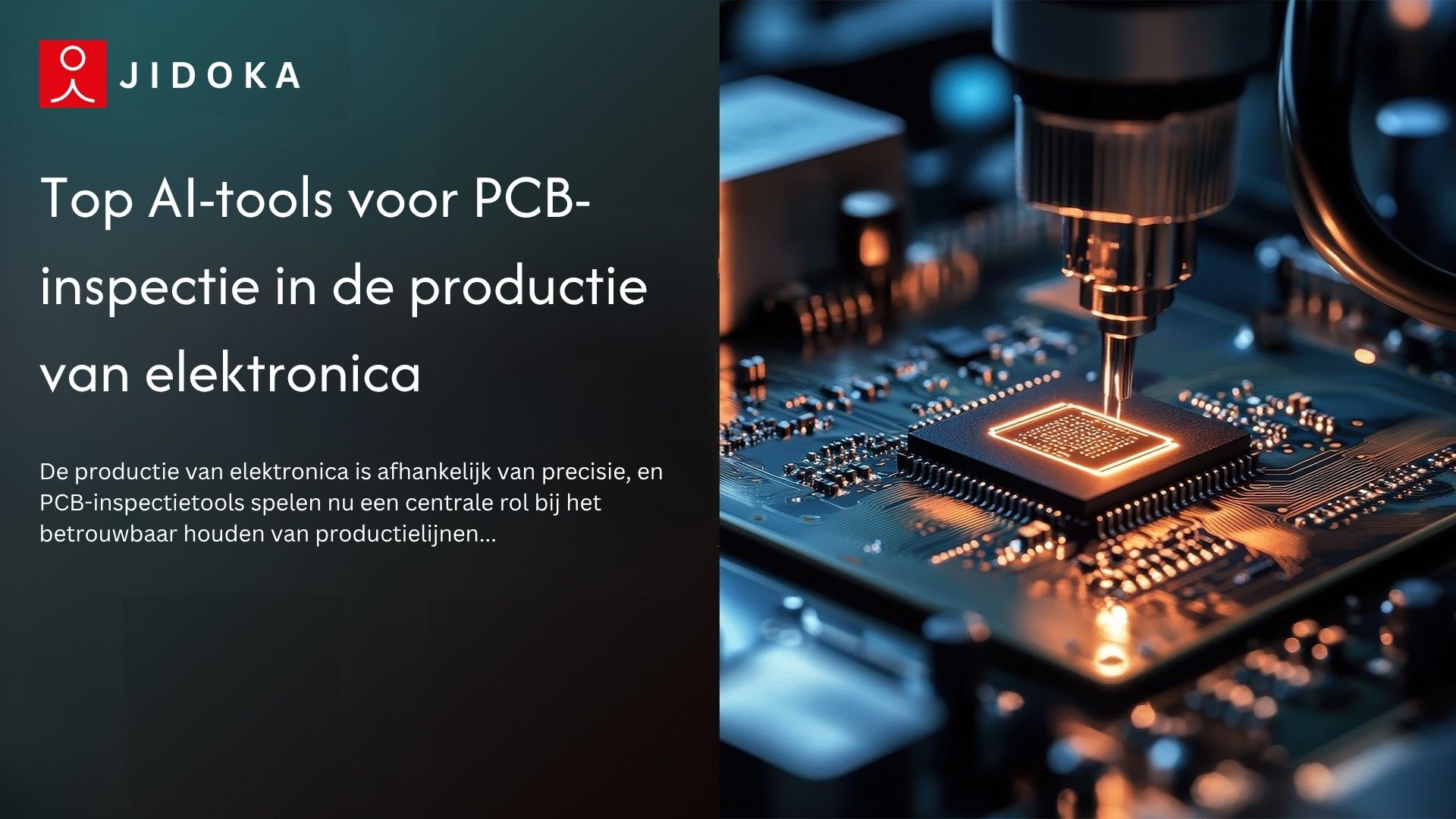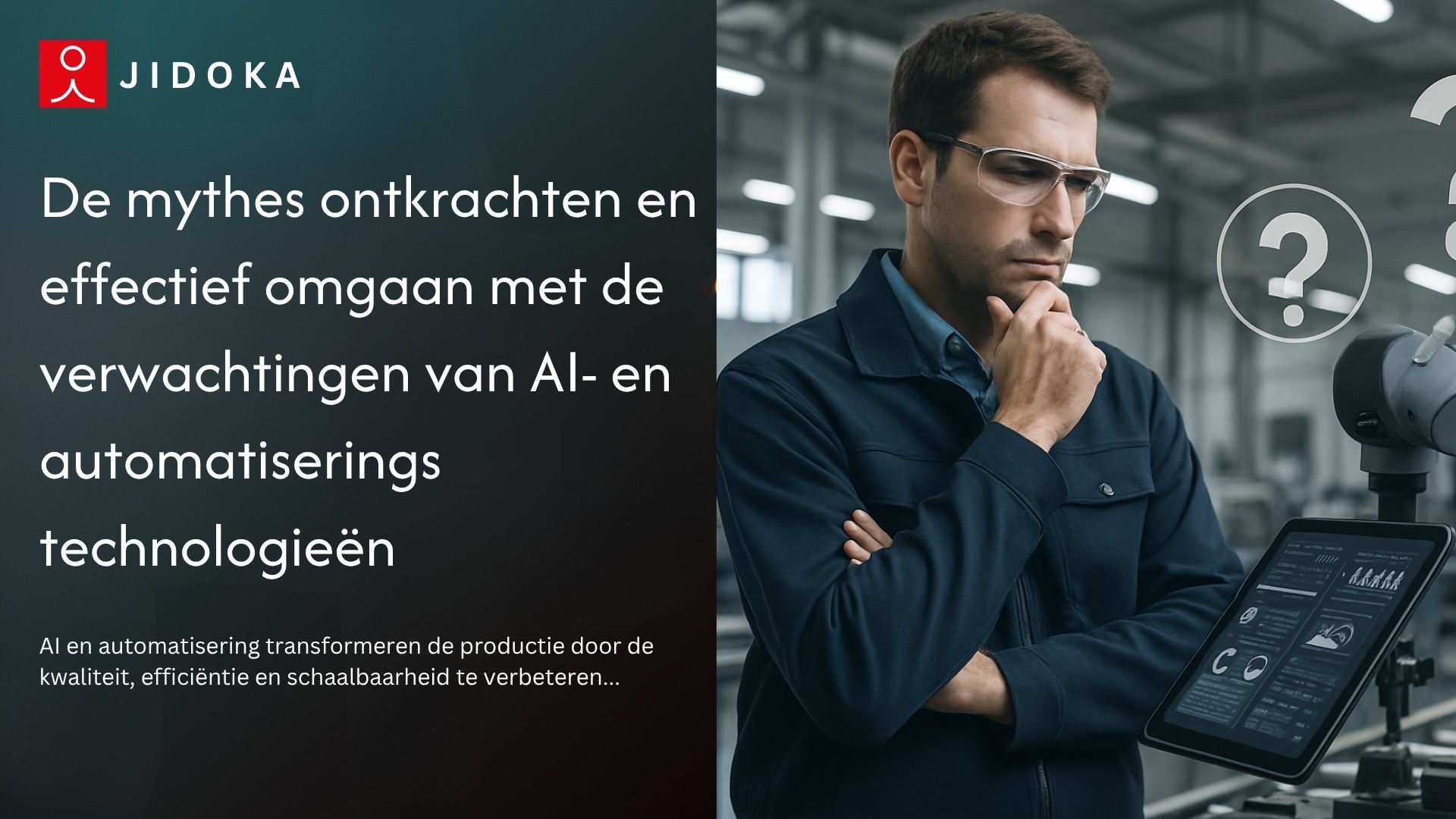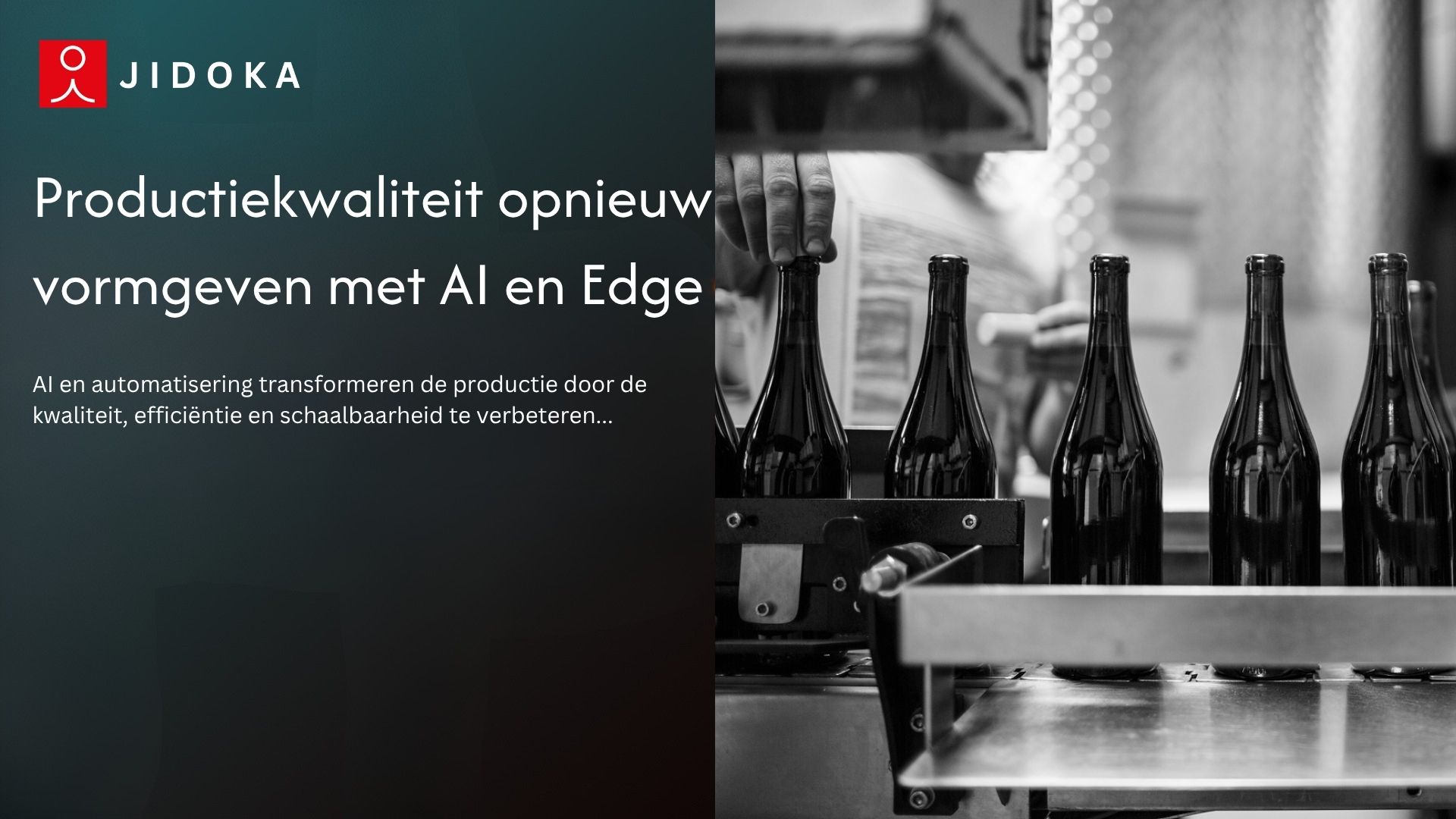Handmatige lasinspecties en kwaliteitscontroles zijn nog steeds de drijvende kracht achter de meeste lasbeslissingen op de werkvloer. Inspecteurs lopen langs de lijn, scannen kralen met het oog en proberen elk probleem op te sporen. Zodra de volumes stijgen en de verbindingen complex worden, begint deze methode defecten te missen.
Volgens ASME-gegevensis ongeveer 32% van de lasfouten het gevolg van fouten van de operator en 41% van slechte procesomstandigheden — beide problemen die geautomatiseerde, op visie gebaseerde inspectie helpt verminderen. Met computervisie met AI kunt u lasinspecties uitvoeren op elk onderdeel, direct op de lijn.
Met Jidoka Tech verandert u de laskwaliteit van een raadspel in een proces dat wordt ondersteund door gegevens.
Waarom uw lasinspectie upgraden met Machine Vision AI?
Traditionele lasinspecties werken voor kleine oplagen en eenvoudige verbindingen, maar kleine foutjes verdwijnen zodra het volume en de complexiteit toenemen. Machine vision met AI geeft je een consistente blik op elk aspect, zodat je problemen op het station oplost en een dataspoor opbouwt dat je kunt vertrouwen.
De grenzen van handmatige lasinspectie vandaag
Handmatige controles hebben het moeilijk als het volume en de variëteit toenemen. Veel voorkomende pijnpunten zijn onder andere:
Wat Machine Vision toevoegt aan de kwaliteitscontrole van lassen
Met machine vision voor de controle van de laskwaliteit maakt u van elke kraal een datapunt:
Als je genoeg hebt van gemiste defecten en rommelige logboeken, laat Jidoka Tech ontwerp een lasinspectie-installatie die draait op gegevens, niet op giswerk.
Kernbouwstenen van een AI-aangedreven lasinspectiecel
Om een lasinspectie op basis van AI in te stellen, moet u de cel zien als een eenvoudige reeks stappen:
1. Beeldbewerking instellen:
- Monteer industriële camera's dicht bij de kraal en stel lasbewaking op basis van industriële camera's in.
- Voeg gecontroleerde LED- of laserverlichting toe voor een scherp contrast voor machinevisie voor de controle van de laskwaliteit.
- Stabiele beelden zorgen ervoor dat de lasinspectie tijdens ploegendiensten consistent blijft.
2. Verwerk de gegevens:
- Stream die beelden naar een edge-pc of GPU.
- Deep learning voor de classificatie van lasdefecten wordt op elk frame uitgevoerd en ondersteunt geautomatiseerde lasinspectiesystemen die defecten taggen en resultaten opslaan.
3. De regelkring sluiten:
- Verbind de modellen met uw PLC of robots.
- Realtime detectie van lasdefecten zorgt voor duidelijke doorloop- of uitvalsignalen, zonder giswerk.
4. Breid de cheques uit:
- Breid dezelfde cel uit met lasnaaddetectie en inspectie van oppervlaktedefecten, zodat het systeem het pad volgt en het oppervlak in één keer controleert.
Klaar om zo'n cel op jouw lijn te bouwen? Praat met Jidoka Tech over een proefproject voor lasinspectie op basis van AI dat is afgestemd op uw onderdelen en productiedoelstellingen.
Lasnaaddetectie: camera's leren om de kraal te volgen
Zodra de lasinspectie op basis van AI is uitgevoerd, begint het systeem de hiel te volgen. Met lasnaaddetectie worden de camera en AI op het gewrichtspad vergrendeld, zodat elke meting en elke beweging van de robot op de plek terechtkomt die u nodig hebt. Installaties die Vision Seam Tracking gebruiken, melden een nauwkeurigheid van het laspad van 0,1 tot 0,2 mm en 20 tot 30 procent minder nabewerking.
A. Van onbewerkte afbeeldingen tot schone naden
Dit is wat er achter de schermen gebeurt:
- Camera's streamen video naar AI-aangedreven lasnaadenanalysemodellen.
- De modellen segmenteren de las, filteren ruis en tekenen een vloeiende middellijn.
- Geautomatiseerde lasinspectiesystemen corrigeren verblinding, kalkaanslag en de positie van het onderdeel, zodat ze altijd weten waar de verbinding loopt.
Een schoon pad zorgt ervoor dat de lasinspecties herhaalbaar zijn voor alle armaturen, operators en ploegendiensten.
B. Naaddetectie gebruiken voor robots en inline-aanpassingen
Zodra de lasnaaddetectie stabiel is, kunt u:
- Voer het naar robotlasinspectieoplossingen, zodat robots de hiel volgen en de opening of offset controleren.
- Activeer de automatisering van de inline-lasnaadinspectie wanneer het pad de grenzen overschrijdt.
Later gebruikt u hetzelfde pad als richtlijn voor de inspectie van oppervlaktedefecten op die las.
Inspectie van oppervlaktedefecten: vroegtijdig scheuren, ondersnijdingen en porositeit vinden
De lasinspectie op basis van AI wordt sterker wanneer u het oppervlak direct na afkoeling controleert. Bij inspectie van oppervlaktedefecten vang je poriën, ondersnijdingen, overlappingen en kleine putjes op terwijl het onderdeel nog steeds in het armatuur zit. Dat geeft u snellere feedback, minder gedoe en minder verrassingen bij de laatste kwaliteitscontroles.
1. 2D versus 3D voor oppervlaktecontroles
Je hebt niet voor elke verbinding zware hardware nodig. Sommige lassen hebben alleen slimme 2D-controles nodig. Veiligheidsonderdelen hebben vaak volledige 3D-weergaven nodig.
2. Niet-destructief onderzoek met Machine Vision
U kunt deze stap behandelen als niet-destructief testen met machine vision.
KPI's en ROI van geautomatiseerde lasinspectiesystemen
De teams van Jidoka Tech gebruiken die weergave waarbij gegevens centraal staan, waarbij AI-visiesystemen een inspectienauwkeurigheid bereiken van 99,5% en het aantal afwijzingen in verband met defecten met ongeveer 15% verminderen. Ze zien ook een ruwweg 20% beter first-pass-rendement in de algemene productie.
A. Kwaliteits- en doorvoerverbeteringen bijhouden
Begin met een gerichte KPI-set:
- Ontsnappingssnelheid voor defecten op elk lasinspectiepunt
- Onjuiste afwijzingen en herwerkuren per regel
- Realtime detectie van lasdefecten per shift
- Gebruik van schroot en verbruiksartikelen op voegen onder inspectie van oppervlaktedefecten
- Cyclustijd per joint en uptime van de line up
Als je deze voor en na de automatisering vergelijkt, zie je hoeveel slechte onderdelen je hebt gestopt en hoeveel inspecteurs zijn overgestapt op werk van hogere waarde.
B. KPI's omzetten in een business case
Zet vervolgens KPI's om in geld en risico:
- Scheurbesparingen en minder garantieclaims op lassen die worden bewaakt met lasnaaddetectie
- Snijden op arbeidsloon en overuren dankzij stabiele lasinspectiecycli
- Snellere terugverdientijd wanneer u één bewezen cel over meerdere lijnen schaalt
Jidoka Tech ziet de ROI vaak in ongeveer 8-16 maanden als deze cijfers zich over de fabrieken verspreiden.
Stapsgewijze routekaart voor de implementatie van Machine Vision voor lasinspectie
Je hoeft niet de hele plant in één keer om te draaien. Begin klein, bewijs de resultaten en schaal vervolgens op.
1. Kies de pilootlijn
Kies één kritieke verbinding en bepaal hoe goede en slechte lasinspectieresultaten eruit zien. Leg beeldvoorbeelden vast voor ploegendiensten en onderdelenvarianten.
2. Offline trainen en testen
Voer die beelden offline in geautomatiseerde lasinspectiesystemen in. Stem modellen en drempels af totdat de defecte gesprekken overeenkomen met wat uw beste inspecteurs verwachten.
3. Ontwikkel gegevens, modellen en regels
Maak datasets schoon, tag defecten en stel duidelijke pass/fail-regels in. Voeg lasnaaddetectie en inspectie van oppervlaktedefecten toe, zodat één cel het pad volgt en het oppervlak in één keer controleert.
4. Ga van schaduwmodus naar automatisering
Voer AI uit in schaduwmodus en vergelijk elke lasinspectiebeslissing met inspectiegesprekken van inspecteurs. Zodra het team het vertrouwt, laat het systeem de alarmen en de automatisering van de inline-lasnaadinspectie beheren.
Conclusie: Lasinspectie klaar maken voor de toekomst met AI
Door AI aangestuurde lasinspectie verandert de laskwaliteit op basis van giswerk in een herhaalbaar, op gegevens gebaseerd proces, waarbij snijontsnappingen vaak met 20-30% voorkomen. Met lasnaaddetectie en inspectie van oppervlaktedefecten in één cel ziet u elke parel, elk defect en elke trend in realtime. Dat betekent minder ontsnappingen, minder nabewerking en schonere audits voor elke shift.
Partners zoals Jidoka Tech gebruik de camera's, modellen en kennis op de grond, zodat uw team met één proeflijn kan beginnen, snel de ROI kan bewijzen en de lasinspecties vervolgens met vertrouwen in alle fabrieken kan opschalen.
Veelgestelde vragen
Hoe werkt de lasinspectie op basis van AI op de werkvloer?
AI-gestuurde lasinspectie maakt gebruik van camera's om elke kraal vast te leggen en stuurt beelden naar modellen voor diepgaand leren voor de classificatie van lasdefecten. Het systeem markeert poriën, ondersneden en missers in realtime en registreert elke beslissing met het oog op traceerbaarheid.
Waar moet ik beginnen als mijn team vandaag alleen handmatige lasinspecties gebruikt?
Kies één verbinding met een hoog risico en voer een AI-lasinspectie uit in de schaduwmodus. Vergelijk de gesprekken met de beslissingen van de inspecteur, pas de drempels aan en laat het systeem alarmen sturen. Deze gefaseerde uitrol schept vertrouwen zonder de productie te verstoren.
Wat is de rol van lasnaaddetectie in een AI-opstelling?
Lasnaaddetectie geeft uw systeem een schoon pad van de verbinding. Het ondersteunt AI-gestuurde lasnaadanalyses, helpt robots op koers te blijven en ondersteunt de automatisering van de inline-lasnaadinspectie voor parels die bewegen of variëren tussen onderdelen.
Hoe past inspectie van oppervlaktedefecten bij andere NDT-methoden bij Jidoka Tech?
Bij Jidoka Tech fungeert de inspectie van oppervlaktedefecten als een snel scherm. Niet-destructief onderzoek met machine vision controleert elke las en stuurt vervolgens alleen risicovolle verbindingen naar X-ray of UT.
Welke hardware gebruikt Jidoka Tech voor geautomatiseerde lasinspectiesystemen?
De meeste Jidoka-opstellingen maken gebruik van lasbewaking op basis van industriële camera's, gecontroleerde LED- of laserverlichting en een edge-pc of GPU om geautomatiseerde lasinspectiesystemen en realtime detectie van lasdefecten uit te voeren.








